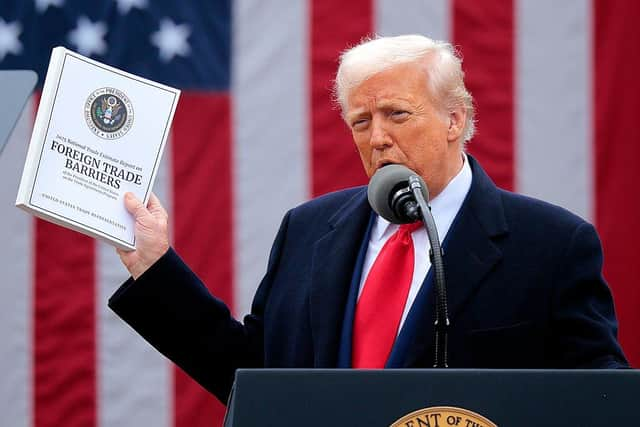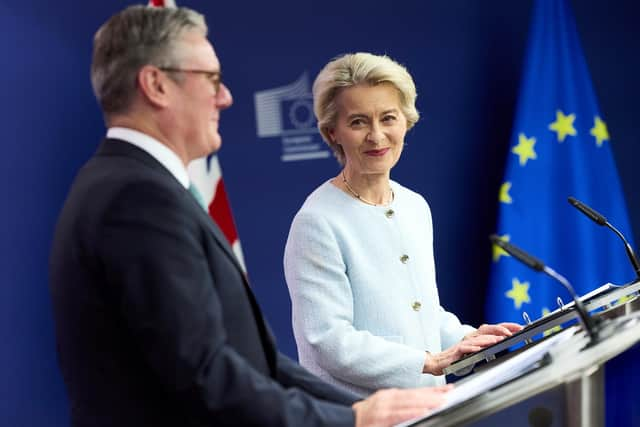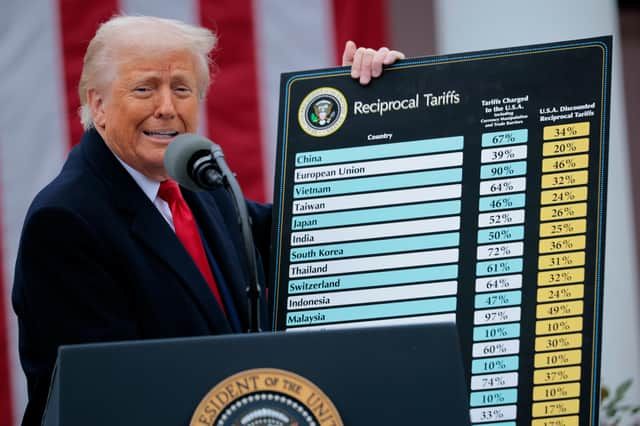Donald Trump has announced sweeping tariffs on all of the US’s trading partners, with 10 per cent set as a minimum
US president Donald Trump has followed through on his threat to introduce sweeping global tariffs on all of American’s trading partners in an announcement he termed ‘Liberation Day’.
A minimum 10 per cent tariff has been set for countries, with the levy to be applied on all US imports of UK goods. However, the 10 per cent tax facing UK goods is half that facing the European Union, which has been particularly targeted by Mr Trump.
The US president hailed the moment as America’s “declaration of economic independence”. During his speech from the White House’s Rose Garden, Mr Trump at one point held up a tariff board, illustrating a breakdown of the levy to be imposed on each country.
Here is what the announcement means for the rest of the world – and how different countries on Mr Trump’s list will be affected.
How will the tariffs work? What goods will be impacted?
Mr Trump has slapped a 10 per cent tariff on US imports of UK goods as he set out sweeping trade levies hitting countries across the world on Wednesday night..
The Republican president confirmed that from midnight in Washington – 5am Thursday in the UK – a 25 per cent tariff would be imposed on all foreign cars imported to the US – a move that experts fear could cost 25,000 jobs in the British car industry.

And he indicated tariffs of 10 per ent would apply to other products from the UK – the same level as the global “baseline” he was setting for countries around the world as part of his “reciprocal” measures from 5am on Saturday. These tariffs will impact the export of Scottish products such as whisky and salmon into the US.
Other blocs with higher tariffs on US goods were hit with tougher import taxes by Mr Trump – for the European Union, which he said would attract a 20 per cent rate.
Speaking in the White House rose garden, Mr Trump said: “April 2, 2025 will forever be remembered as the day American industry was reborn, the day America’s destiny was reclaimed, and the day that we began to make America wealthy again.”
What countries were on Trump’s tariff list? What tariff will each country be charged?
The baseline tariff rate is 10 per cent and will come into affect from Saturday.
The UK is set to be levied at this minimum rate, but other countries are not so lucky. Here is the full list of tariffs:
Countries only facing the base 10% rate
- United Kingdom
- Singapore
- Brazil
- Australia
- New Zealand
- Turkey
- Colombia
- Argentina
- El Salvador
- United Arab Emirates
- Saudi Arabia
- Chile
- Peru
- Costa Rica
- Dominican Republic
- Ecuador
- Guatemala
- Honduras
- Egypt
- Trinidad and Tobago
- Oman
- Uruguay
- Bahamas
- Ukraine
- Bahrain
- Qatar
- Iceland
- Kenya
- Haiti
- Bolivia
- Panama
- Ethiopia
- Ghana
- Jamaica
- Paraguay
- Lebanon
- Tanzania
- Georgia
- Senegal
- Azerbaijan
- Uganda
- Albania
- Armenia
- Nepal
- Sint Maarten
- Gabon
- Kuwait
- Togo
- Suriname
- Belize
- Papua New Guinea
- Liberia
- British Virgin Islands
- Afghanistan
- Benin
- Barbados
- Monaco
- Uzbekistan
- Republic of the Congo
- Djibouti
- French Polynesia
- Cayman Islands
- Kosovo
- Curaçao
- Republic of the Congo
- Djibouti
- French Polynesia
- Cayman Islands
- Kosovo
- Curaçao
- Saint Kitts and Nevis
- Turkmenistan
- Grenada
- Sudan
- Turks and Caicos Islands
- Aruba
- Montenegro
- Saint Helena
- Kyrgyzstan
- Yemen
- Saint Vincent and the Grenadines
- Niger
- Saint Lucia
- Iran
- Samoa
- Guinea
- Timor-Leste
- Montserrat
- Mali
- Maldives
- Tajikistan
- Cabo Verde
- Burundi
- Guadeloupe
- Bhutan
- Martinique
- Tonga
- Mauritania
- Dominica
- Micronesia
- Gambia
- French Guiana
- Christmas Island
- Andorra
- Central African Republic
- Solomon Islands
- Mayotte
- Anguilla
- Cocos (Keeling) Islands
- Eritrea
- Cook Islands
- South Sudan
- Comoros
- Kiribati
- São Tomé and Príncipe
- Gibraltar
- Tuyalu
- British Indian Ocean Territory
- TokelauGuinea-Bissau
- Svalbard and Jan Mayen
- Heard and McDonald Islands
Higher tariffs for other ‘worst offender’ countries
Sixty countries branded as the “worst offenders” by Mr Trump will be hit with higher tariffs of up to 60 per cent. These will go into effect on April 9. They include:
- China: 34%
- European Union: 20%
- Vietnam: 46%
- Taiwan: 32%
- Japan: 24%
- India: 26%
- South Korea: 25%
- Thailand: 36%
- Switzerland: 31%
- Indonesia: 32%
- Malaysia: 24%
- Cambodia: 49%
- South Africa: 30%
- Bangladesh: 37%
- Israel: 17%
- Philippines: 17%
- Pakistan: 29%
- Sri Lanka: 44%
- Peru: 10%
- Nicaragua: 18%
- Norway: 15%
- Jordan: 20%
- Madagascar: 47%
- Myanmar (Burma): 44%
- Tunisia: 28%
- Kazakhstan: 27%
- Serbia: 37%
- Côte d’Ivoire: 21%
- Laos: 48%
- Botswana: 37%
- Algeria: 30%
- Lesotho: 50%
- Mauritius: 40%
- Fiji: 32%
- Liechtenstein: 37%
- Guyana: 38%
- Bosnia and Herzegovina: 35%
- Nigeria: 14%
- Namibia: 21%
- Brunei: 24%
- Venezuela: 15%
- North Macedonia: 33%
- Moldova: 31%
- Angola: 32%
- Democratic Republic of the Congo: 11%
- Mozambique: 16%
- Zambia: 17%
- Iraq: 39%
- Cameroon: 11%
- Falkland Islands: 41%
- Malawi: 17%
- Zimbabwe: 18%
- Syria: 41%
- Vanuatu: 22%
- Saint Pierre and Miquelon: 50%
- Nauru: 30%
- Equatorial Guinea: 13%
What is a reciprocal tariff? How do they work?
Irish deputy premier Simon Harris has been among those saying there is a need for “maturity” in negotiations between the European Union and the US, when it comes to any prospect of a reciprocal tariff. But what is a reciprocal tariff?
A reciprocal tariffs is a levy calculated as the tariff rate necessary to balance bilateral trade deficits between the US and each of our trading partners.
The European Union has suggested it may respond in kind to the 20 per cent tariff imposed by Mr Trump’s administration with a reciprocal levy.
The EU is finalising its first package of countermeasures, with commission president Ursula von der Leyen warning Europe was prepared for further retaliation if necessary.

In a speech early on Thursday, Ms Von der Leyen said: “We are prepared to respond. We are already finalising the first package of countermeasures in response to tariffs on steel and we’re now preparing for further countermeasures to protect our interests and our businesses if negotiations fail.
“We [Europe] are in this together: if you take on one of us, you take on all of us. Our unity is our strength.”
Prime Minister Sir Keir Starmer has told business chiefs that “clearly, there will be an economic impact” from Mr Trump’s tariffs, but the government would respond with “cool and calm heads”.




